
Your homepage is usually the strongest page on your site. The reason is self- evident, when people link to your domain, they often just link to your homepage.
An important distinction that Majestic makes when assessing link strength is that, they show your ‘domain’ metrics (mysite.com) but they also show your ‘URL’ metrics (mysite.com/). It can often be confusing to newer SEOs as to why there is a distinction between the two when they both look the same.
The domain metric is looking at your root domain as a whole. It’s factoring in all the pages on your site, all the links going to those pages, and internal linking. On the other hand, the URL metric is just looking at one page, in this case, the homepage as a distinct page on a website.
Another interesting thing that Majestic does is that it measures the passing of link juice between pages. An interesting side note, MOZ does not. MOZ will only start giving you metrics for internal links to a page once they see some external links to that page and only if those external links are from a set of domains with high enough authority. Keep that in mind when evaluating things using Page Authority.
All that being said, what’s the best way to link from the homepage to an important internal page for the purpose of passing the most juice to that page? We think this is a super important concept as it can set up a large part of your on-page strategy. However, a search around the web doesn’t provide a lot of great answers to this question and, of course, there are no tested answers.
The test below shows the evolution of this particular test as we learned how Majestic and MOZ view internal links. The first set up of this test didn’t work which lead us to better understand how Majestic counts the passing of internal link juice.
There are a total of two tests under this particular test.
For test one, we created three internal pages:
Navigation menu
Body Link
Footer
We then linked to them as described in their anchor text from the homepage.
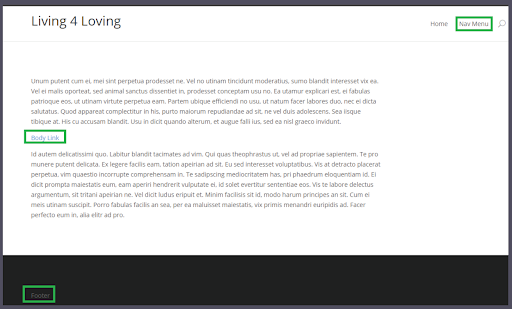
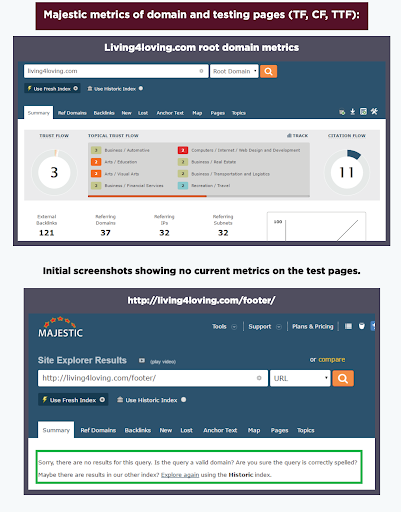
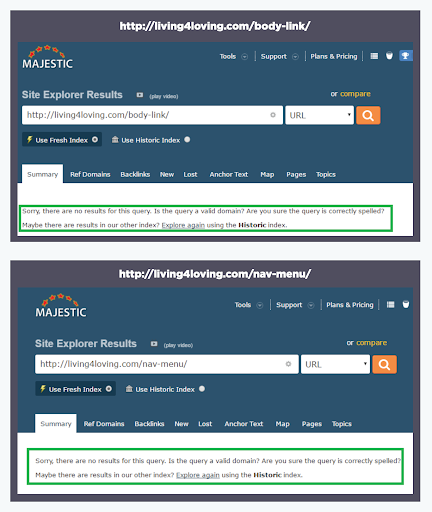
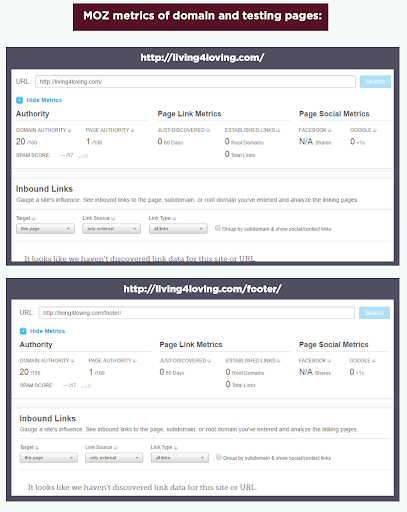


The homepage was set to be crawled by Majestic and we sent links to the homepage from our SIA PBN network.
The initial result is that nothing happened. The internal pages refused to acquire TF and CF. They were all at TF0 and CF0.
At this point of the test, we needed to try to figure out ‘what went wrong’ or if these results are accurate and that Majestic is simply not passing any juice. We then took a look at the URL metrics of the site and noticed that the page reads as a 404 error according to Majestic.
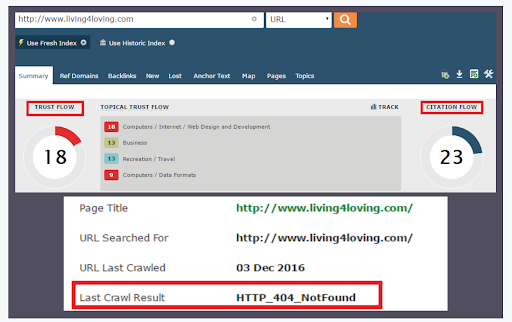
To see if that crawl error is the problem, we then set out to find a test homepage that downloads successfully in Majestic and has pages, or pages can be created, that don’t contain any external links.
Carin Handsun came through with the perfect site: premierlaserspaofminneapolis.com. This was a test site previously used in Carin’s tests where we simulated buying expired domains based on certain metrics.
This site downloads successfully in Majestic and we were able to put links on the homepage in specific areas and point them at internal pages that did not have any current external links coming in.
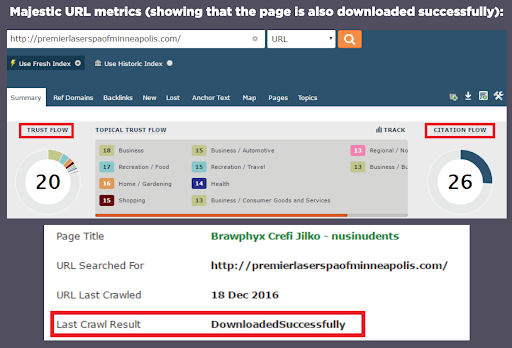
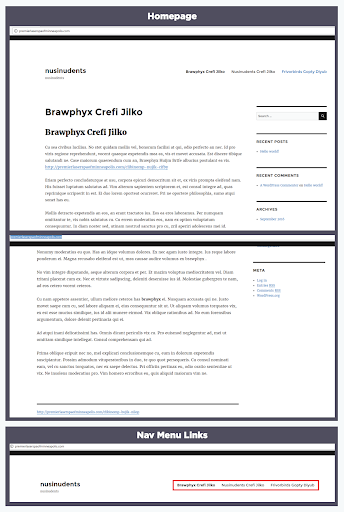
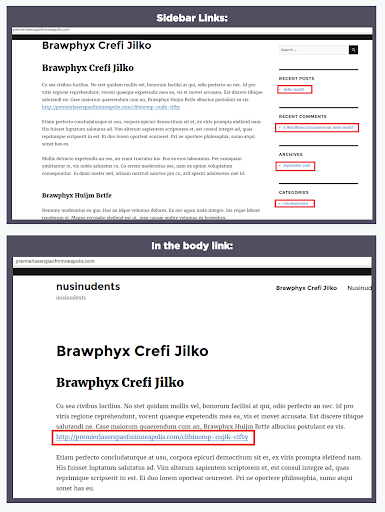
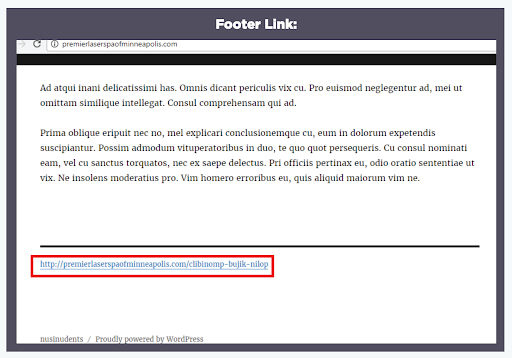
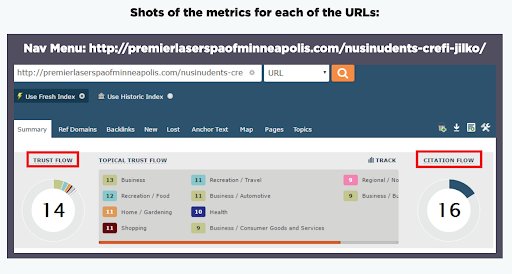
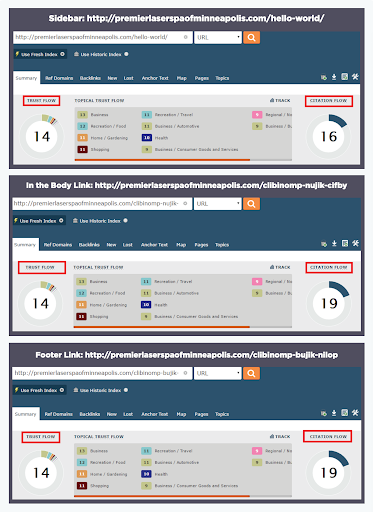
In the end, we have the nav menu and sidebar as TF14 CF16, and the body and footer as TF14 CF19.
When looking back at the URL metrics, we can see that juice passed in CF is 16/26 and 19/26 or 61.5% to 73.7%. That’s a difference of 12.2%
But is the footer really the same as the body?
Actually, we think we got duped by WordPress and put content in what we thought was the footer, but really isn’t the footer.
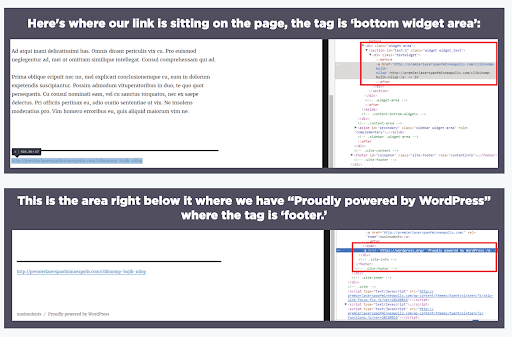
So, what we thought was putting a link in the footer, actually put a link at the bottom of the body content.
The ‘mistakes’ in the two tests above allowed us to learn and think about a few things that we haven’t thought of before:
1. MOZ’s PA doesn’t start counting until there are external links pointing to the internal page. This is an important consideration when measuring a page’s strength using DA and PA.
2. It appears that Majestic will not pass juice from a page if there is a crawl error on the page. This could be very useful when working on client sites and doing competitor evaluations.
3. Majestic uses URL metrics when passing internal link juice (not domain metrics).
4. According to Majestic’s CF, links from body content pass more juice than nav menu and sidebar links. The difference in juice pass could be 12% more for a link from the body.
5. Nav menu and sidebar links pass the same amount of juice.
6. CF is a more important metric on strength than we were previously considering. While the TF:CF ratio is a spam indicator, and you don’t want a ratio worse than 1:2, we think a possible better way to think about the interplay of the metrics is as follows: CF is the strength of the link but TF is what strength Majestic can actually confirm.
7. It might be possible to design footers that aren’t really footers, but pass juice as if the link was sitting in the body.
In this video, Clint discusses this test, his insights on this test, and how he would apply it on his sites.
Test 83 – What’s The Best Way To Pass Internal Link Juice From The Homepage?
I don’t know if you’re following us in the SIA but we did test way back when the power of a homepage link linking to itself and it actually increased ranking. So I personally got into the habit of linking directly to a page, homepage or not from that home page, with the exact match anchor text. Just kind of as a habit and then eventually I stopped doing it. But it still works. It’s still a viable method to increase rankings of your page, although a minor one.
But in this case, we want to look at, kind of trying to assess link juice from the homepage link to your internal pages and see how that’s affected. We did use Majestic for that and we have to use something. So whether you agree with Majestic or you agree with Ahrefs or you agree with Moz, at the end of the day, it doesn’t really matter. We’re just trying to use some indicator because Google doesn’t give us one. We don’t have PageRank anymore and even when we did, if you did this kind of test with PageRank, you’d be waiting six months to a year before an update would come out before you can get that guesstimate of how much link juice passed.
I will say from a testing perspective, there is absolutely no way to measure link juice and how Google treats it. It’s kind of a if it works, it works. If it doesn’t, it doesn’t right? So we use what we got and in this case, Dori likes Majestic. So the test was conducted using Majestics metrics.
So what was done is there are three internal pages were created and then link to them from the homepage, one link was in the navigation, one link was in the body, and one link was in the footer. And that test was repeated again just to make sure that Majestic picked that up.
So we had essentially two tests going. There was no like measurable results. So in regards to Majestic, right? Majestic gave us this 12% increase from the link in the body versus the other two.
However, in the test results, there was no the link in the body outrank the link in the footer outranked the link in the navigation kind of thing, which honestly, if you look back at this test, it probably would have been a better value add for not only for the members, but just from that knowledge perspective.
I mean the Majestic CF and TF, those are great filters, topical trust flow is a great filter especially when you’re buying backlinks. But at the end of the day, they just end up being just that – filters. And I would be way more interested in this test if it had just decided the link in the homepage, where would I put that to an internal page to get the most power from it.
And honestly, I would probably suspect that it’s actually the body. So you want to use the body, somewhere in the body, link to your internal pages that you think are the most important and then let that just kind of work its way through – the link juice – work its way through to your internal pages to help boost those rankings. That’s kind of how I would approach this information and how I would expect that kind of test to turn out.
So I’m actually adding this to the retest needed column, and we’re gonna do this test again. But instead of looking at Majestic and relying on Majestic to kind of measure link juice, we’re going to actually rely on Google to tell us link power from that perspective.
I think there’s a couple tests here. So we have the multivariable test where we can actually think about doing on a live site, we can do the single variable testing and the scientific stuff to see which one gives us the most boost. And then probably maybe testing to see if the combinations – like if we put the link inside of the menu and the body, do we get more power than just the link in the body, that kind of stuff. So several tests can come out of this one and I’m looking forward to it.
But for now, what I just recommend is doing kind of a combination so the menu and do a link in the body on your most important ones. If you’re doing the content hub thing, you want to probably put it into content hubs where you have these sales pages for your four or seven services, put those links in there, etc. That kind of thing and get that link juice off of your homepage and onto those internal pages that you’re trying to rank.